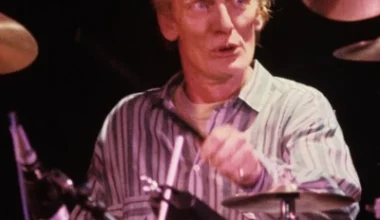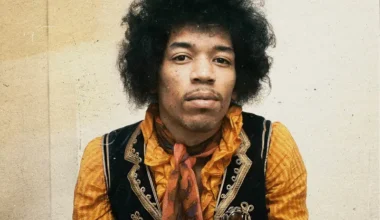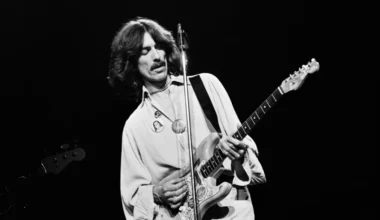It was the summer of 1966.
The Beatles were in the middle of a tour that included five gigs in three days at Japan’s legendary Nippon Budokan venue, but when they weren’t performing, they were holed up in the presidential suite of the Tokyo Hilton, creating a work of art known as “Images of a Woman.”
On February 1, Christie’s auction house in New York sold the painting, which some experts believe to be the only artwork created by all four Beatles (or at least signed by all four).
“Images of a Woman” is expected to cost between $400,000 and $600,000 and “crystallizes a magical moment in Beatles history,” according to Christie’s specialist Casey Rogers in a phone interview. The eventual sale price was over three times the high end of that projection, at $1,744,000.
“It’s such a rarity to have a work on paper outside of their music catalog that is a physical relic, this tangible object with contributions from all four of The Beatles,” Rogers said of the painting, which measures 21.5 by 31 inches.
“It’s memorabilia, a work of art, and appeals to a wider range of collectors…, It’s an excellent bit of narrative.
How ‘Images of a Woman’ was created
During their 1966 tour, the Beatles reportedly spent over 100 hours in Japan.
Outside of performances (and except on two occasions when Paul McCartney and John Lennon slipped out with members of their entourage for sightseeing adventures in Tokyo), the band remained in their hotel room at the request of local authorities concerned about their safety. The band’s visit to the country brought both admiring fans and protesters. There were reports of threats from Japanese nationalists, some upset that a Western rock band performed in an arena considered a spiritual home for martial arts.
According to Christie’s press release, a visitor gave them some art tools, and the band quickly gathered around a table with a blank sheet of Japanese art paper in the center and a lamp roughly positioned on top. Each Beatle sat in a corner, painting something different. Recordings for the upcoming album “Revolver” played in the background.
The band’s manager Brian Epstein hired photographer Robert Whitaker, who was on hand to capture the Beatles at work. “I never saw them calmer or more contented than at this time,” he said, according to Christie’s statement.
The Beatles were not new to visual art. Lennon attended art school, and McCartney had also studied the topic. Both George Harrison and Ringo Starr drew “often and with plenty of talent,” the Christie’s press release added.
Each corner of the artwork represents a personal touch, with a wide range of shapes, colors, and even paints employed. Harrison’s section, characterized by darker and stronger brush strokes, seems to sprawl the most from his corner. In contrast, Starr’s part is smaller and exhibits a more cartoonish style. Christie’s reported that Lennon and McCartney generally used acrylic, but Harrison and Starr preferred watercolor.
The center now displays the signatures where the lamp used to sit.
The Beatles did not give their painting an official title, but it became known as “Images of a Woman” in the late 1980s when “a Japanese journalist thought he could see female genitals in Paul’s quadrant,” according to Christie’s.
Rogers actively stated, “It’s all very much in the eye of the beholder, isn’t it”? “The creation of the painting did not necessarily have that objective in mind. I believe it was more fluid, free-form, and just the members expressing themselves.”
Other interpretations have emerged over time, and they will likely continue to have varying meanings.
Tetsusaburo Shimoyama, an entertainment business mogul and chairman of Tokyo’s Beatles fan club at the time, purchased the artwork when it was completed. In 1989, record store owner Takao Nishino bought it, and The Atlantic reported that he auctioned “Images of a Woman” in 2012.
Nishino, upon deciding to part with the painting, declared to The Atlantic that he initially believed it was best for him to retain it as a piece of Japan’s cultural legacy. It has never left Japanese land in 46 years. However, the Beatles’ phenomenon was and continues to be global.
The enduring appeal of The Beatles
Beatlemania has persisted in the decades since the band’s breakup, and as Rogers observed, “they’re never out of the headlines”. Interest in the band’s music, members’ lifestyles, and contributions to pop culture contribute significantly to their “perennial” appeal, she said.
“We’re even seeing them in the news as recently as (last month) with the help of AI”. She remarked, referring to the publication of “Now and Then,” a long-unfinished song now completed using Artificial Intelligence.
“Images of a Woman” was part of Christie’s “Exceptional Sale,” a yearly auction conducted in New York, London, and Paris.
“These are masterpiece-level, often one-of-a-kind rare objects with historical importance,” said Rogers. He spotlighted The Beatles’ artwork in an auction with rock memorabilia, art, sports relics, and more.
Though not generally appreciated or even known, “Images of a Woman” was the outcome of a singular event in the band’s history. By the end of August 1966, less than two months after departing Japan, The Beatles had played their last concert. One 1969 rooftop performance notwithstanding, they concluded their strenuous touring at San Francisco’s Candlestick Park. This marked the shift of their focus to studio work.
“I believe ‘Images of a Woman’ accurately captures their 100-hour collaboration… Rogers stated that it was probably one of the last times they could sit together and reflect. They didn’t have schedules that necessitated them to be anyplace other than Budokan for their shows.
“And maybe, at the same time, it was a release during this lockdown,” she said. “Just this great creative outlet for them.”








